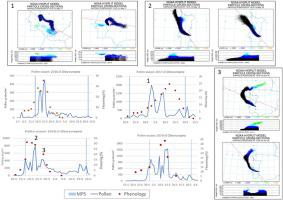当前位置:
X-MOL 学术
›
Urban Forestry Urban Green.
›
论文详情
Our official English website, www.x-mol.net, welcomes your
feedback! (Note: you will need to create a separate account there.)
HYSPLIT as an environmental impact assessment tool to study the data discrepancies between Olea europaea airborne pollen records and its phenology in SW Spain
Urban Forestry & Urban Greening ( IF 6.0 ) Pub Date : 2020-08-01 , DOI: 10.1016/j.ufug.2020.126715 Alejandro Monroy-Colín , José María Maya-Manzano , Rafael Tormo-Molina , Raúl Pecero-Casimiro , María Ángeles Gonzalo-Garijo , Santiago Fernández-Rodríguez
Urban Forestry & Urban Greening ( IF 6.0 ) Pub Date : 2020-08-01 , DOI: 10.1016/j.ufug.2020.126715 Alejandro Monroy-Colín , José María Maya-Manzano , Rafael Tormo-Molina , Raúl Pecero-Casimiro , María Ángeles Gonzalo-Garijo , Santiago Fernández-Rodríguez

|
Abstract The olive tree (Olea europaea) is a native evergreen tree in the Mediterranean region, being one of the most important causes of seasonal respiratory allergies in Mediterranean countries. This work aims to relate flowering phenology, source tree distribution, meteorology, and airborne pollen records for this species and to analyse the possible arrival of air masses from distant areas during days when differences between the phenological and pollen peaks. Aerobiological sampling was carried out in Badajoz (SW Spain) for 4 years (2016–2019) using a Hirst volumetric sampler. Trees were geolocalized in the city and surrounding areas. The pollination phenology of 15 specimens was studied for four years (2016–2019) during the months from April to June. The daily data for the whole period and the hourly data for the four years, including pollen records and meteorology, were analysed. The comparison between the pollen records and sources distribution was assessed. The main pollen season (thereafter, MPS) lasted an average of 34.5 (29–40) days. Phenological observations indicate that pollination occurred for 26.5 days and was mostly within the period of recorded airborne pollen; however, were days with airborne pollen recorded outside the pollination period. In 2017 the peak day was recorded when the flowering period has reached only the 10%, in other seasons this value reached the maximum peak of pollen concentration was found only a few days after the maximum of flowering. The hourly analysis showed that the maximum pollen concentrations were reached just after noon. The analysis of pollen sources and pollen records showed a close relationship with the predominant winds and tree distributions. The observed discrepancies between phenological and aerobiological data (in 2017 and 2018) were explained by the movement of air masses and long-distance transport.
中文翻译:

HYSPLIT 作为环境影响评估工具,用于研究西班牙西南部 Olea europaea 空气传播花粉记录与其物候学之间的数据差异
摘要 橄榄树(Olea europaea)是地中海地区的原生常绿乔木,是地中海国家季节性呼吸道过敏的最重要原因之一。这项工作旨在关联该物种的开花物候、来源树分布、气象学和空中花粉记录,并分析在物候峰和花粉峰之间存在差异的日子里,来自遥远地区的气团可能到达。使用赫斯特容积采样器在巴达霍斯(西班牙西南部)进行了为期 4 年(2016-2019 年)的空气生物采样。树木在城市和周边地区进行了地理定位。在 4 月至 6 月的几个月中,对 15 个标本的授粉物候进行了四年(2016-2019 年)的研究。整个时期的日数据和四年的小时数据,包括花粉记录和气象学,进行了分析。评估了花粉记录和来源分布之间的比较。主要花粉季节(此后,MPS)平均持续 34.5(29-40)天。物候观察表明,授粉时间为 26.5 天,大部分在有记录的空气传播花粉期间;然而,在授粉期之外记录了空气传播花粉的天数。2017年开花期仅达到10%时就出现了高峰日,在其他季节,这个值达到了花粉浓度的最大高峰,仅在开花高峰后几天才发现。每小时的分析表明,中午刚过,花粉浓度就达到了最大值。花粉来源和花粉记录的分析表明,与主导风和树木分布密切相关。观察到的物候和空气生物学数据(2017 年和 2018 年)之间的差异是由气团运动和长途运输造成的。
更新日期:2020-08-01
中文翻译:

HYSPLIT 作为环境影响评估工具,用于研究西班牙西南部 Olea europaea 空气传播花粉记录与其物候学之间的数据差异
摘要 橄榄树(Olea europaea)是地中海地区的原生常绿乔木,是地中海国家季节性呼吸道过敏的最重要原因之一。这项工作旨在关联该物种的开花物候、来源树分布、气象学和空中花粉记录,并分析在物候峰和花粉峰之间存在差异的日子里,来自遥远地区的气团可能到达。使用赫斯特容积采样器在巴达霍斯(西班牙西南部)进行了为期 4 年(2016-2019 年)的空气生物采样。树木在城市和周边地区进行了地理定位。在 4 月至 6 月的几个月中,对 15 个标本的授粉物候进行了四年(2016-2019 年)的研究。整个时期的日数据和四年的小时数据,包括花粉记录和气象学,进行了分析。评估了花粉记录和来源分布之间的比较。主要花粉季节(此后,MPS)平均持续 34.5(29-40)天。物候观察表明,授粉时间为 26.5 天,大部分在有记录的空气传播花粉期间;然而,在授粉期之外记录了空气传播花粉的天数。2017年开花期仅达到10%时就出现了高峰日,在其他季节,这个值达到了花粉浓度的最大高峰,仅在开花高峰后几天才发现。每小时的分析表明,中午刚过,花粉浓度就达到了最大值。花粉来源和花粉记录的分析表明,与主导风和树木分布密切相关。观察到的物候和空气生物学数据(2017 年和 2018 年)之间的差异是由气团运动和长途运输造成的。











































 京公网安备 11010802027423号
京公网安备 11010802027423号